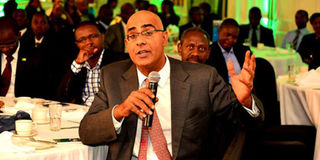Interbank rate up as lenders pay Sh22bn tax

Rich Management Chief Executive Officer Aly-Khan Satchu responds to a question at an investors' meeting to announce the full year 2014 financial results, at Hilton Hotel on February 26, 2015. He said the interbank rate had reversed sharply after it fell to record lows in early June touching 2.23. PHOTO | SALATON NJAU | NATION MEDIA GROUP
What you need to know:
- Banks borrow and lend money to each other in order to manage liquidity and meet the regulatory requirements placed on them.
- Dr Njoroge said there was a need to reform the market and provide ways of making it effective to translate to lower borrowing costs for individuals and businesses.
Banks last week raised the price at which they lend to each other as the industry remitted billions of shillings in tax to the Treasury, squeezing out liquidity.
Tax transfers from banks to the government hit Sh22.2 billion, causing the average interbank rate to double.
“Liquidity in the money market remained tight after banks remitted the quarterly tax payments for June 2016. Consequently, the average interbank rate increased significantly by 419 basis points to 8.12 per cent in the week ending June 29, 2016, from 3.93 per cent in the previous week,” the Central Bank of Kenya said in its weekly brief.
Rich Management Chief Executive Aly Khan Satchu said the interbank rate had reversed sharply after it fell to record lows in early June touching 2.23.
“The interbank rate had collapsed to a multi-year low. I think, therefore, some reversion to the mean was to be expected and that in fact the Central Bank would surely prefer a more balanced and in equilibrium overnight rate. So yes, this correction was expected and the tax-related reasoning is also correct,” said Mr Satchu.
The financial analyst said the interbank market had largely become a Tier 1 interbank market affair, which may not reflect the general market conditions.
CBK Governor Patrick Njoroge had previously pointed out the skewed relationship in the interbank market noting that an elite group of about eight banks were rigging the market to maintain monopoly.
“About eight banks holding around 80 per cent of the deposits are lending to each other at very low rates. But not everyone is in that club, the rest are getting very high rates,” he said at an earlier press briefing.
Banks borrow and lend money to each other in order to manage liquidity and meet the regulatory requirements placed on them.
The interbank rate is also an indication of the cost and supply of money in the economy.
Dr Njoroge said there was a need to reform the market and provide ways of making it effective to translate to lower borrowing costs for individuals and businesses.





